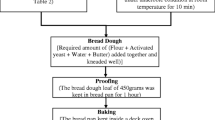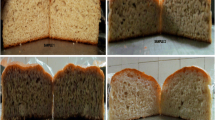Abstract
In this research, quinoa flour (QF) and buckwheat flour (BF) were used up to 20 % in the formulation of bread, replacing wheat flour. The formulated breads were evaluated for physical quality parameters, chemical and sensory properties. The highest ratios of QF and BF adversely affected volume and hardness values of the breads. Generally Fe, K, Mg, Mn, and Zn contents of the breads increased with increasing levels of QF and BF. While phytic acid content of the control bread was found to be 53.23 mg/100 g; this antinutrient increased up to 137.80 mg/100 g with 20 % QF usage. Bread containing 10 % QF or BF gave similar sensory scores compared to control. Also, bread produced with a QF:BF blend (50:50 w/w) at a 20 % level replacing wheat flour gave good sensory quality values except for pore structure.
Similar content being viewed by others
References
AACC (1990) Approved methods of the American Association of Cereal Chemists, 8th edn. AACC, St Paul
Aydın C, Öğüt H (1991) Determination of some biological properties of Amasya apple and hazelnuts. Selcuk Univ J Agri 1:45–54 in Turkish
Bojnanska T, Francakova H, Gazar R (2009) Influence of buckwheat addition on technical and nutrition quality of bread. Acta Fytotechnica Zootech Minariadne CISL 57–63
Bonafaccia G, Kreft I (1994) Technological and qualitative characteristics of food products made with buckwheat. Fagopyrum 14:35–42
Bubert H, Hagenah WD (1987) Detection and measurement. In: Boumans PWJM (ed) Inductively coupled plasma emission spectroscopy. Wiley-Interscience Publishers, New York, pp. 536–567
Chauhan GS, Eskin NAM, Tkachuk R (1992) Nutrients and antinutrients in quinoa seed. Cereal Chem 69(1):85–88
Dini A, Rastrelli L, Saturnino P, Schettino O (1992) A compositional study of Chenopodium quinoa seeds. Nahrung 36:400–404
Harland BF, Harland J (1980) Fermentative reduction of phytate in rye, white and whole wheat breads. Cereal Chem 57(3):226–229
Haugh W, Lantzsch HJ (1983) Sensitive method for the rapid determination of phytate in cereals and cereal products. J Sci Food Agric 34:1423–1426
Kozioł M (1992) Chemical composition and nutritional evaluation of Quinoa. (Chenopodium quinoa Willd). J Food Compos Anal 5:35–68
Lin LY, Liu HM, Yu Y, Lin SD (2009) Quality and antioxidant property of buckwheat enhanced wheat bread. Food Chem 112(4):987–991
Lorenz K, Coulter L (1991) Quinoa flour in baked products. Plant Foods Hum Nutr 41:213–223
Marshall HG, Pomeranz Y (1982) Buckwheat: Description, breeding, production, and utilization. In: Pomeranz Y (ed) Adv Cereal Sci and Tech. AACC, St. Paul, pp. 157–203
Morita N, Hirata C, Park SG, Mitsunaga T (2001) Quinoa flours as a new foodstuff for improving dough and bread. J Appl Glycosci 48(3):263–270
Ranhotra GS, Gelroth BK, Glaser BK, Lorenz KJ, Johnson DL (1993) Composition and protein nutritional quality of quinoa. Cereal Chem 70(3):303–305
Rickard ES, Thompson LU (1997) Interactions and effects of phytic acid. In: Shahidi F (ed) Antinutrients and phytochemicals in foods. American Chemical Society, Washington, DC, pp. 294–312
Schlick G, Bubenheim DL (1996) Quinoa: Candidate crop for NASA’s controlled ecological life support systems. In: Janick J (ed) Progress in new crops. ASHS Press, Arlington, pp. 632–640
Skrabanja V, Kreft I, Golob T, Modic M, Ikeda S, Ikeda K, Kreft S, Bonafaccia G, Knapp M, Kosmelj K (2004) Nutrient content in buckwheat milling fraction. Cereal Chem 81(2):172–176
Steadman KJ, Burgoon MS, Lewis BA, Edwardson SE, Obendorf RL (2001) Minerals, phytic acid, tannin and rutin in buckwheat seed milling fractions. J Sci Food Agri 81:1094–1100
Vega-G’alvez A, Miranda M, Vergara J, Uribe E, Puenteb L, Mart’ınezc EA (2010) Nutrition facts and functional potential of quinoa (Chenopodium quinoa willd.), an ancient Andean grain: a review. J Sci Food Agric 90:2541–2547
Wijngaard HH, Arendt EK (2006) Buckwheat. Cereal Chem 83(4):391–401
Author information
Authors and Affiliations
Corresponding author
Additional information
Research Highlights
1. Quinoa flour (QF) and buckwheat flour (BF) were used in bread formulation up to %20 level.
2. The highest ratios of QF and BF gave low volume and hard texture in bread.
3. QF and BF improved Fe, K, Mg, Mn, and Zn contents of breads.
4. All levels of QF and BF significantly (p < 0.05) increased phytic acid content of breads.
5. Bread containing 10 % QF or BF gave similar sensory scores to control.
Rights and permissions
About this article
Cite this article
Bilgiçli, N., İbanoğlu, Ş. Effect of pseudo cereal flours on some physical, chemical and sensory properties of bread. J Food Sci Technol 52, 7525–7529 (2015). https://doi.org/10.1007/s13197-015-1770-y
Revised:
Accepted:
Published:
Issue Date:
DOI: https://doi.org/10.1007/s13197-015-1770-y




